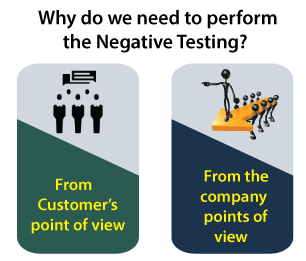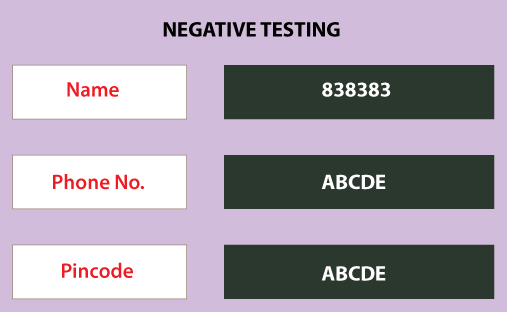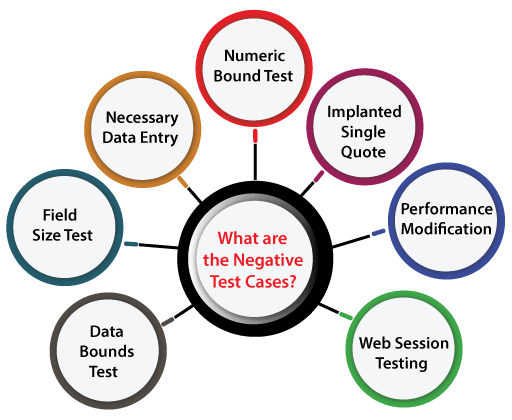Negative TestingSoftware testing is all about checking the application whether it is working according to the given requirement or not. We may have to use various software testing types like functional testing, Unit testing, Integration system, System testing, smoke testing, regression testing, and sanity testing to complete the process. Software development is not an easy take to complete because it is all about writing extensive and complex codes and then testing these composite codes to guarantee faultless and constant performance. As we know, software testing is an essential aspect of writing a successful code. However, all of these came into the following two categories, such as:
In this section, we are going to cover the following topics related to the particular testing technique known as negative testing:
What is Negative Testing?It is a unique type of software testing technique used to evaluate the system for unpredicted circumstances. It plays a very significant role in high-performance software development. In this testing, the system is authorized by giving the invalid data as input. A negative test analyzed if an application performs as predictable with its negative inputs. 
Mainly, negative testing is used to checks whether such unpredicted situations will be the software's performance. In other words, we can say that negative testing is implemented to guarantee that the software product under test does NOT fail when an unpredicted input is given. It is also known as failure testing or error path testing. The Objective of Negative Testing
Attributes of Negative TestingHere, we are discussing some of the essential characteristics of negative testing, which are as follows:
Why do we need to perform the Negative Testing?Subsequently, performing any type of testing activity is a cost and time-taking process. So, we have to select sensibly whether we need to implement the negative testing in our system or not. Here, we are discussing why we need to perform negative testing in the particular application by considering the following preservatives of clients, organizations: 
From Customer's point of view
From the company's point of view
Example of Negative TestingIn negative testing, the software product's implementation is evaluated with the help of invalid data inputs. When unexpected parameters are entered, the response of the software is tested. In such conditions, the application should display the following error message: Invalid data input. For example: Suppose we have one sample form to enter the values for the name, phone number, and Pincode fields. In such case, the negative input could be the following: Name: 838383 (As the name field only accepts the alphabetic character value) Phone No: ABCDE (As the Phone no field only accepts the he values of the number) Pincode: ABCDE (As the Pincode field only accepts the he values of the number) 
How to perform Negative TestingTo implement the negative testing, the test engineer needs to look out for all the possible scenarios. Specifically, if it is achievable, we have to think about it in the Test Case no matter whether it is not the right way to use it. For example1: Suppose we see an image upload option, so we have considered all probable inputs, and we can put there to test it with all possible files. For example2: Similarly, we have an email field, and we have to think about all possible inputs, and we can put them there other than the correct email format. Note: In negative testing, we have to select the cases before implementation to save time and testing cost.What is a Negative Test Case?Another significant component of negative testing is Negative test cases. The team creates these negative test cases to test the application in a way where it is not meant to be used. As we understood that the negative testing is performed to ensure the constancy and dependability of the application. And these should be measured by the team in the following testing efforts:

The testing team must test all the lower and upper bounds for data fields.
The functional specifications should specify the number of characters one can enter into a field. To ensure that this limit is not exceeded, we can write a test case. It helps prevent users from incoming more characters before getting error messages after they have surpassed the limit.
Each field in the software which involves data entry on the screen should be verified before the critical data is entered in the particular field.
In order to make sure the negative test cases are accurate, the testing team needs to analyze both the lower and upper bounds.
Some software systems come across an issue when the end-users try to store information containing a single quote. Hence, for all the screens which receive alphanumeric data entry, the specific team should provide the text that involves one or more single quotes.
The test suite should contain test cases that compare previous and current release performance statics, which could help in categorizing potential performance problems.
As we know that, various web applications vary on browser sessions to display several user information. And the testing team prepares the test cases to release web pages within the application that don't involve users log in. Negative Test ScenariosThe usage of negative testing enhances the test coverage of a software product or an application and finds the possible application failure in different conditions. Following are some of the negative cases and test scenarios:
Advantages of Negative TestingSome of the significant benefits of negative testing are as discussed below:
Disadvantages of Negative TestingHowever, the implementation of negative testing is helpful for an enhancement of an application, but there are still some drawbacks of negative testing, which are discussed below:
OverviewIn this tutorial, we have understood the concept of negative testing. And after seeing all the relatable topics of negative testing, we can conclude that negative testing makes sure that the delivered software has no bugs and can be restrained in its usage by the customer. To design the detailed and powerful negative test scenarios requires a creative, skilled, foresight, and intelligent test engineer. As we know, each software development company desires to have capable and robust software that needs to undertake severe negative testing. People often live under the delusion that Negative Testing is one more way of enhancing the expenditures without any possible benefits. This thought is significant as it can compromise the excellence of the final software product. In the end, we can say that by implementing Negative Testing, we can enhance the quality of the software and make it stronger.
Next TopicPositive Testing
|
 For Videos Join Our Youtube Channel: Join Now
For Videos Join Our Youtube Channel: Join Now
Feedback
- Send your Feedback to [email protected]
Help Others, Please Share










